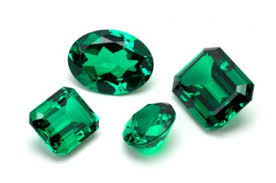Emerald (Be3Al2SiO6) is a gemstone or precious stones in green to dark green. Emeralds including silicate mineral beryl (containing beryllium) and the green color is caused by trace chromium. The existence of vanadium and chromium iron accompanying trace will cause a wide zone in the green color. Emerald including high hardness (7.5 in Mohr scale).
Producing high quality emeralds are Colombia, Siberia, South Africa, Zimbabwe, Australia, and Brazil.
A fine emerald must possess not only a pure verdant green hue as described below, but also a high degree of transparency to be considered a top gem

Emerald tends to have numerous inclusions and surface breaking fissures. Unlike diamond, where the loupe standard, i.e. 10× magnification, is used to grade clarity, emerald is graded by eye. Thus, if an emerald has no visible inclusions to the eye (assuming normal visual acuity) it is considered flawless. Stones that lack surface breaking fissures are extremely rare and therefore almost all emeralds are treated ("oiled", see below) to enhance the apparent clarity. The inclusions and fissures within an emerald are sometime described as "Jardin" (French for 'garden'), because of their mossy appearance.[12] These imperfections within the stone are unique to each emerald and can be used to identify a particular stone. Eye-clean stones of a vivid primary green hue (as described above) with no more than 15% of any secondary hue or combination (either blue or yellow) of a medium-dark tone command the highest prices.[5] This relative crystal non-uniformity makes emeralds more likely than other gemstones to be cut into cabochons, rather than faceted shapes. Faceted Emeralds are most commonly given the Oval cut, or the signature Emerald cut, a rectangular cut with facets around the top edge.
Producing high quality emeralds are Colombia, Siberia, South Africa, Zimbabwe, Australia, and Brazil.
A fine emerald must possess not only a pure verdant green hue as described below, but also a high degree of transparency to be considered a top gem
Emerald tends to have numerous inclusions and surface breaking fissures. Unlike diamond, where the loupe standard, i.e. 10× magnification, is used to grade clarity, emerald is graded by eye. Thus, if an emerald has no visible inclusions to the eye (assuming normal visual acuity) it is considered flawless. Stones that lack surface breaking fissures are extremely rare and therefore almost all emeralds are treated ("oiled", see below) to enhance the apparent clarity. The inclusions and fissures within an emerald are sometime described as "Jardin" (French for 'garden'), because of their mossy appearance.[12] These imperfections within the stone are unique to each emerald and can be used to identify a particular stone. Eye-clean stones of a vivid primary green hue (as described above) with no more than 15% of any secondary hue or combination (either blue or yellow) of a medium-dark tone command the highest prices.[5] This relative crystal non-uniformity makes emeralds more likely than other gemstones to be cut into cabochons, rather than faceted shapes. Faceted Emeralds are most commonly given the Oval cut, or the signature Emerald cut, a rectangular cut with facets around the top edge.
Tidak ada komentar:
Posting Komentar